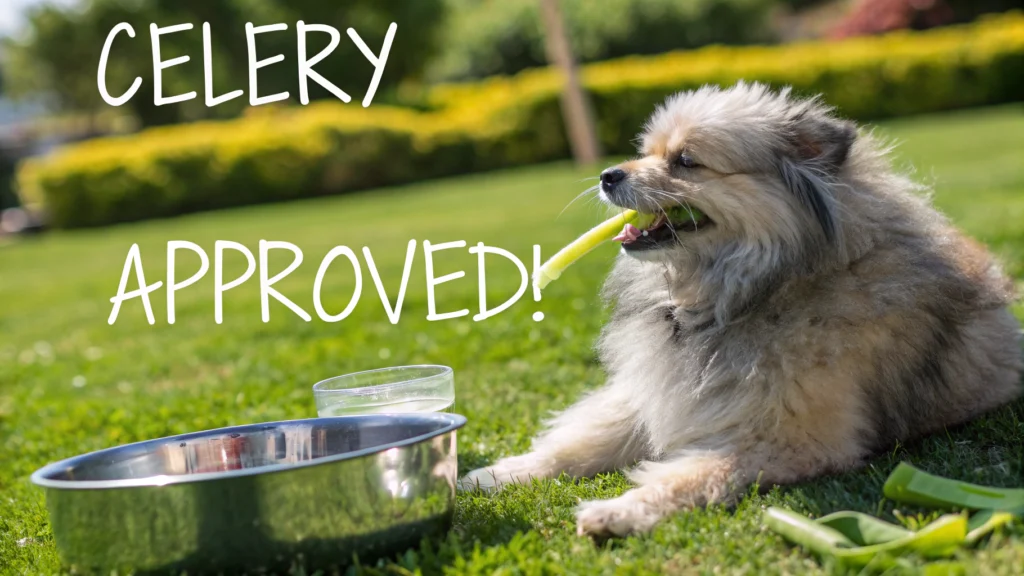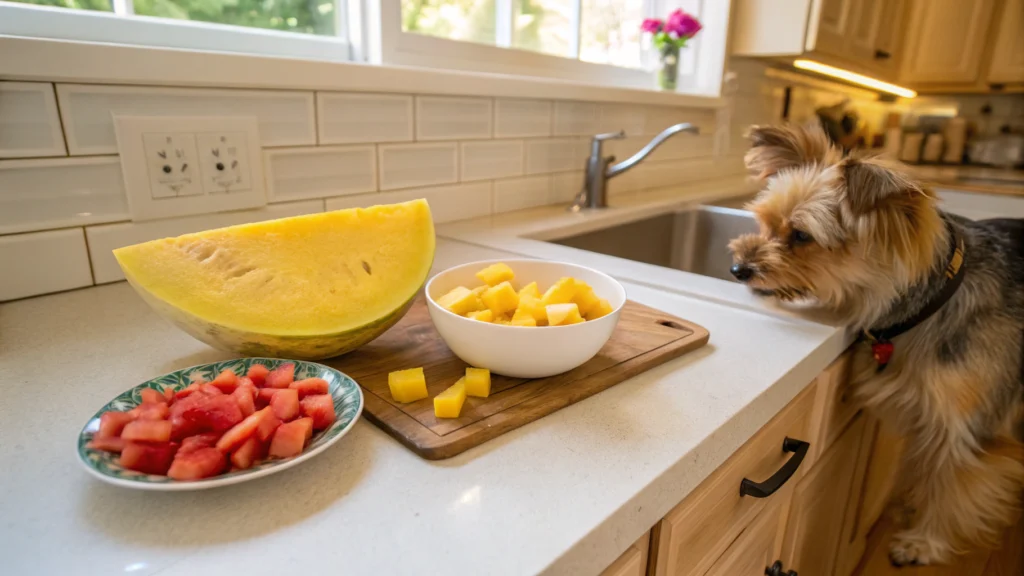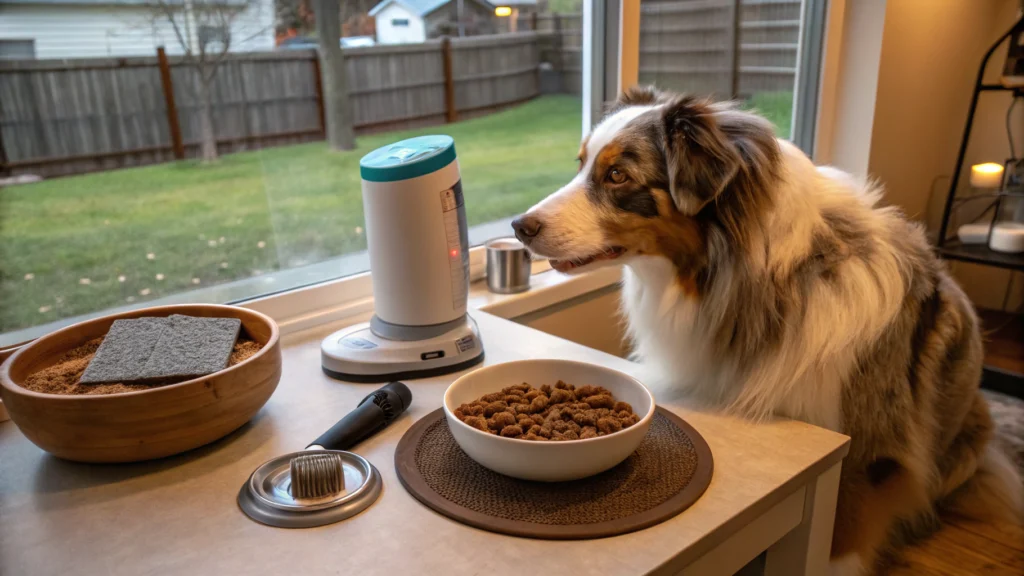
Celery is a crunchy, low-calorie vegetable often praised for having health benefits for people, but can dogs eat celery? This complete guide will answer whether celery is safe for dogs, health benefits, risks, preparation, and using in your dog’s diet.
Is Celery Safe for Dogs?
The answer is YES to whether celery is safe for dogs to eat, if done in moderation. Celery is not considered toxic food for dogs and can be considered a healthy treat in moderation for most dogs. The American Kennel Club (AKC) and other veterinary sources confirm that celery is safe for dogs to eat if prepared properly. When introducing any new food to your dog, always introduce it in moderation, so your dog can decide if or how much they want to eat.
Key Things to Note
Moderation: While celery can be a healthy treat for your dog, it should be considered an occasional treat and not as regular part of your dog’s diet. For healthy dogs, treats (including vegetables) should not be more than 10% of their daily calories.
Individual Sensitivities: Remember dogs are individuals, some dogs may have some sensitivities to digesting celery or some may even be allergic, so you will want to be vigilant when they are first introduced to celery.
Preparation: You will need to cut the celery accordingly to their individual size, so that you can avoid choking or digestive issues.
Can Celery Be Good for Dogs?
The nutritional benefits of drinking celery
Celery can be a nutritious snack for dogs in moderation, as it is full of nutritious vitamins and minerals. Here is a summary of its nutritional composition and advantages:
- Low in Calories
This makes an excellent snack for dogs that may be overweight, or following a weight management plan, since it is only about 16 calories per 100 grams. Not only does it taste great, but dogs also love crunching. - High in Fibre
The fibre found in celery can assist healthy digestion, allowing things to be pushed along and being a good remedy for dogs that may suffer from constipation. Although too much fibre can certainly spark gas or diarrhea, it is still important to manage how much is fed. - Vitamin and Mineral Content
- Vitamin A – great for healthy eyesight, healthy skin/coat condition
- Vitamin C – Antioxidant, may help boost the immune system
- Vitamin K – important for blood clotting and healthy bones.
- Potassium – important for muscle function and heart health
- Folate- helpful for cell division and growth.
Hydration
Celery provides quite a fair amount of water to your dog’s diet as well, as it is about 95% water, therefore it allows for some hydration within their usual food. It can also help to hydrate your dog, when it is hot out, or after a very active play!
Antioxidants
Celery has antioxidant properties from flavonoids and phenolic compounds which may help reduce inflammation and combat oxidative stress.
Dental Health
Chewing on celery can help clean your dog’s teeth by scraping off plaque and tartar. Chewing on celery can also boost saliva production to benefit the mouth.
Potential Risks to Feeding your Dog Celery
Most dogs are fine eating celery, but there are some risks to watch out for:
- Choking Hazard
Celery can be very fibrous and stringy and can create a choking hazard. This may especially true for small dogs or dogs that tend to swallow food without chewing. Make sure to cut celery into small, bite size pieces before giving them to your dog to limit the choking hazard.
- Digestive Upset
If fed too much celery, the high fiber content could lead to gas, bloating, or diarrhea. This can be a bigger concern if your dog already has a sensitive stomach.
- Sodium Content
Celery contains a small amount of natural sodium. Again, generally not a problem in moderation. However, if a dog has a heart or kidney issue, or needs a low sodium diets, you should speak to your vet.
- Allergies
Although rare, some dogs can have allergies to celery. You should consider stopping celery if you notice itchiness, swelling, trouble breathing and contact your cats veterinarian.
- Pesticide Residue
Celery consistently ranks as one of the “Dirty Dozen” for high pesticide residue in human food. Always adequately wash celery or buy organic celery to minimize chemical exposure.
How to Prepare Celery for Dogs
Properly preparing celery for dogs is an important process to ensure the celery is safe and enjoyable for dogs. Follow these steps:
- Wash Thoroughly
Celery should be rinsed well under running water to remove dirt, bacteria, and pesticide residues. Organic celery is an even better choice in order to minimize chemical exposure.
- Remove Strings
The fibrous strings in celery can be difficult for dogs to digest and also can cause choking. Remove the strings by peeling or snapping the stalks to break the strings free.
- Cut into Small Sizes
It’s a good idea to chop celery into small pieces that are the appropriate size for the size of your dog. For small dogs, they should be no bigger than ¼ inch; for larger dogs, ½ inch to 1 inch is acceptable.
- Raw or Cooked?
Raw celery. Most dogs love the crunchiness of raw celery, which also helps with dog’s dental hygiene. Make sure you cut the celery into small pieces to prevent choking.
Cooked celery. Cooked or steamed celery is going to be a little softer and possibly easier to digest for dogs with sensitive stomachs or dogs who do not have teeth. Make sure that you do NOT add any salt, butter, spices, or oils.
- Avoid Additives
Never feed dogs celery mixed with additives such as garlic, onion, high-fat dipping sauces , and salt. These ingredients can be toxic or cause digestive upset in dogs.
How much celery can dogs have?
The safe quantity of celery for dogs will largely depend on their size, weight, and needs in their diet. A general guideline per day can be as follows:
Small dogs (i.e. Chihuahua, 5 to 15 lbs): 1 to 2 small pieces (~ 1 to 2 tablespoons of celery).
Medium dogs (i.e. Beagle, 20 to 50 lbs): 2 to 4 small pieces (~ ¼ cup of celery).
Large dogs (i.e. Labrador, 50 to 100 lbs): 4 to 6 small pieces (~ ½ cup of celery).
When feeding celery to dogs, always start with a small amount and gauge your dog for any signs of digestive upset. If you have concerns about portion sizes or would like to confirm the amount your dog should have with particular health conditions, please consult your veterinarian.
Creative Advancement of Feeding Celery to Dogs
Feeding celery to dogs presents many possibilities. Here are a few:
- Celery Sticks
Using peeled small pieces, you can offer small celery sticks as a crunchy treat. Just cut the pieces down to a reasonable portion for your dog.
- Frozen Celery
If your dog is a fan of frozen treats, freeze the slices of celery in a preferred shape as a treat on a hot summer day. If your dog is a teething puppy, the frozen celery will have the nice added benefit of soothing their little, sore gums.
- Celery with Peanut Butter
Using celery sticks spread with a thin layer of dog-safe peanut butter (xylitol-free) will be a tasty and protein-filled snack for your dog. Make sure your dog-safe peanut butter does not contain any artificial sweetener – xylitol is very toxic to dogs.
- Mixed with Dog Food
Finely chop celery then mixed with your dog’s regular kibble or wet food to add texture and nutrients to your dog’s meal.
- Homemade Dog Treats
You can mix celery with other dog-safe food items (e.g., carrots, apples, or pumpkin) and bake them into homemade dog biscuits.
When Not To Feed A Celery Stick
Celery may not be appropriate for some dogs. It is best to avoid to feed your dog celery if they:
Has had history of digestive issues or food intolerance/allergies.
Is on a restricted feeding program medically due to concurrent medical conditions (e.g., kidney disease or heart disease).
Displays signs of discomfort or allergic reactions after consuming celery.
It is wise to check with your veterinarian first before introducing new foods into your dog’s diet especially if there are ongoing health issues or if your dog is on medication or a restricted diet.
Frequently Asked Questions of can dogs eat celery
- Can puppies eat celery?
Yes, puppies can have celery in moderation but should be cut into small bits to avoid a choking hazard. Be sure to introduce celery slowly, as some puppies have sensitive stomachs that can be upset.
- Can dogs eat celery leaves?
Yes, dogs can eat celery leaves too. The nutritional value is about the same as celery stalks but they may be a little bitter and some dogs may not like them. Be sure to wash the leaves and cut them into small pieces before feeding them.
- Can dogs eat celery seeds?
Celery seeds are usually not recommended for dogs. They have a concentrated amount of celery and could upset a dog’s stomach or create other problems. Go with the leaves and stalks only.
- What vegetables are safe for dogs?
Some vegetables that are safe for dog consumption (cook or raw) include carrots, green beans, broccoli, cucumber, and pumpkin. Always introduce new foods slowly and gradually.
- What if my dog eats too much celery?
If your dog eats a lot of celery and then shows signs of digestive upset like vomiting or diarrhea, then you should contact a veterinarian. In most situations, if it’s something mild it usually runs it’s course. Nevertheless, keep a close eye on your pet.
Conclusion
Celery can be a healthy low-calorie treat for dogs when prepared safely and fed in moderation. Some nutritional benefits include vitamins and minerals, as well as hydration benefits. A good snack in moderation, and the crunch does help with dental health. Choking hazards, digestive issues, and even individual sensitivities to celery all need to be accounted for. Make sure to contact your veterinarian If you don’t know if you should offer your dog celery, or if your dog has specific health needs.
The guidelines in this article will allow you to share celery with your furry best friend safely and add a crunchy, nutritious treat to their diet!
you may like it








sources
- Link: https://www.akc.org/expert-advice/nutrition/can-dogs-eat-celery/
- Link: https://www.petmd.com/dog/nutrition/can-dogs-eat-celery
- Link: https://www.rover.com/blog/can-dogs-eat-celery/



Food & Nutrition”; “Exploring the Unconventional: Can I Feed My Dog Pickles? Delve into the briny world of cucumbers and vinegar, understanding the potential risks and benefits of sharing pickles with your furry friend.